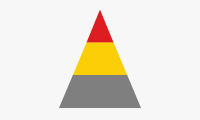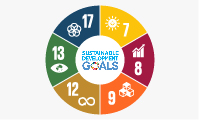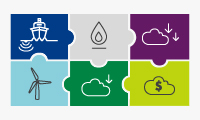Reporting against aspirations
This table represents a selection of global metrics that we track within Shell. These metrics have been selected because they reflect the direct impact of our operations on people and the environment. We used them to set our goals and measure progress in 2017 and to define priorities for 2018.
We review our metrics regularly to ensure we capture the information needed to improve our performance. For example, we introduced Goal Zero for personal safety at Shell in 2007. Since then, we have broadened the goal to aim for no harm to people and the environment. The metrics used to measure our greenhouse gas performance of refineries and chemical plants changed in 2017, and further changes to upstream and integrated gas emissions are planned for 2018. More information on our performance, definitions of the indicators and the referenced goals are provided in the environmental, social and safety data sections.
Goals, performance and plans for 2017 and beyond
Personal safety
Personal safety
Goal 2017
TRCF < 0.9
Achieve total recordable case frequency (TRCF) – the number of injuries per million working hours – below 0.9 for employees and contractors.
Goal Zero has been our ambition for personal safety since 2007.
Progress in 2017
Total recordable case frequency (TRCF)
In 2017, we achieved our lowest ever number of injuries. (See Safety performance).
Priorities in 2018
- In road safety, continue to focus on effective implementation of proven practices across all lines of business.
- Support the development and implementation of common industry safety standards.
- Improve our capabilities to capture insights from audit findings and investigations into incidents with the potential to cause harm.
Process safety
Process safety
Goal 2017
Leaks < 130
Achieve a number of operational leaks below 130 (classified as “operational Tier 1 & 2 process safety events”).
Since 2011, we have extended our ambition of Goal Zero to process safety.
From 2017, we combined operational Tier 1 & 2 safety events when setting the target. Previously, we only used Tier 1 events.
Progress in 2017
Number of operational process safety Tier 1 and 2 events
We saw an increase in leaks in 2017 compared to 2016. (See Safety performance).
Priorities in 2018
- Strong focus on asset integrity and quality of operational execution, including through the group-wide roll out of our Process Safety Fundamentals.
- Continue to improve learning from process safety events with high potential impact.
Environment
Environment
Goal 2017
Goal Zero extends to the environment with our goal of no operational spills.
Progress in 2017
Volume of operational spills in ‘000 tonnes
In 2017, we had the lowest volume of operational spills we have ever recorded. (See Environmental performance).
Priorities in 2018
- Continue to learn from incidents with spills to improve the reliability of our facilities and further reduce the number and volume of operational spills.
- Continue to work with the oil and gas industry to further develop effective oil-spill response capacities.
GHG & Energy
GHG & Energy
Goal 2017
Flaring emissions < 8.1
Reduce flaring in our upstream business (million tonnes CO2 equivalent)
Our policy is to reduce any continuous flaring or venting to as low as level as reasonably practical.
We are a signatory of the World Bank’s “Zero routine flaring by 2030” initiative.
Progress in 2017
Flaring in million tonnes CO2 equivalent [A]
[A] We have updated our 2017 upstream flaring from 8.0 million tonnes of CO2 equivalent as published in our 2017 Annual Report and Form 20-F to 8.2 million tonnes following finalisaton of 2017 data. The scorecard outcome for 2017 was not affected by this update.
(See Flaring).
Priorities in 2018
- Continue to link staff bonuses to the management of greenhouse gas emissions.
- In November 2017, Shell and seven other energy companies signed guiding principles for reducing methane emissions across the natural gas value chain.
GHG & Energy
GHG & Energy
Goal 2017
Refinery GHG intensity < 1.15
For our refineries, achieve a GHG intensity below an intensity of 1.15 tonnes of CO2 equivalent per Solomon’s Utilised Equivalent Destillation Capacity [UEDC™]
Chemicals GHG intensity < 0.45
For our chemical plants, achieve a GHG intensity below an intensity of 0.45 tonnes of CO2 equivalent per tonne of petrochemicals produced
(See Energy efficiency).
Progress in 2017
Refineries: tonnes CO2e per Solomon’s Utilised Equivalent Destillation Capacity [UEDC™]
Chemicals: tonnes CO2e per tonne of petrochemicals produced
In 2017, we have changed our metric for reporting from energy intensity to GHG intensity, and can currently provide data for three years of performance.
Priorities in 2018
- Continue to link staff bonuses to the management of greenhouse gas emissions.
- Continue to focus on maintenance measures to enhance the reliability of our equipment and reduce emissions through leaks.
Social performance
Social performance
Goal 2017
Effective community feedback
Our community feedback mechanism (CFM) has been used to address community concerns since 2012. We continue to progress the implementation of our standard online community feedback tool which helps to strengthen tracking and reporting of concerns.
Progress in 2017
We conducted a full evaluation of our online community feedback tool to understand how it has been used across our projects and facilities. Following the evaluation, we identified a number of areas for improvement, which are now being considered to enhance the tool.
We developed the CFM self-check to assess the effectiveness of the mechanism based on UN Guiding Principles and Human Rights criteria for implementation in all major facilities and projects.
(See Social performance).
Priorities in 2018
- Aim to enhance the online community feedback tool, based on the improvement areas we identified in 2017, for example, the user friendliness to ensure short response times. The improvements help to ensure we are able to effectively track and record feedback, and support projects and facilities in responding quickly to concerns.
- Identify further improvement opportunities for the CFM implementation from the self-check exercise, to meet the UN Guiding Principles and Human Rights effectiveness criteria.
 Sustainability at Shell
Sustainability at Shell
 Sustainable development goals
Sustainable development goals
 About our data
About our data
 Energy transition and climate change
Energy transition and climate change